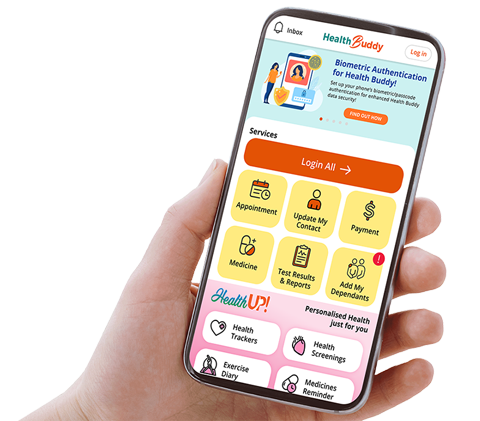Sengkang General Hospital will NEVER ask you to transfer money over a call. If in doubt, call the 24/7 ScamShield helpline at 1799, or visit the ScamShield website at www.scamshield.gov.sg
Not All It's Cracked Up to Be
Neck cracking may help relieve pain and stiffness but how safe is this practice? Our experts share insights on this practice, shedding light on the risks and offering tips on managing neck pain.
In high-stress, workaholic Singapore, it is not surprising that a significant proportion of the population suffers from neck pain.
“A recent local study1 found that 23% of the Singapore population suffer from neck of which 6.3% were chronic and 8.3% severe,” reports Dr Chen Haobin, Consultant, Department of Orthopaedic Surgery, Sengkang General Hospital (SKH). “Neck pain is a common symptom that results in significant disability and affects the quality of life,” he adds.
This finding is consistent with studies done worldwide, which show that neck pain increases with age, peaking in the 70 to 74-year-old age group. Females were 1.34 times more likely to present with neck pain than males.
Neck Cracking Is Not for Everyone
To find relief, many resort to self-administered neck cracking or seek the help of experts such as physiotherapists, chiropractors and masseurs. However, there are certain risks to watch out for.
Generally harmless, cracking your own neck can stretch the facet joints which connect the spinal bones, providing flexibility to the spine. “It is important to note that the benefits are primarily psychological though,” notes Dr Chen.
Self-administered neck cracking is not for everyone. Dr Chen explains that people with underlying spinal injuries, pre-existing spinal nerve compression, or certain underlying medical conditions, such as rheumatoid arthritis, should avoid it. Cracking their necks could worsen underlying spinal injury or instability, which may result in serious spinal cord or nerve damage.
Patients with pre-existing spinal nerve compression — especially if there is pain, numbness or weakness in the upper limbs — should similarly refrain from neck cracking. “It may aggravate these nerve impingement symptoms,” Dr Chen warns. “The difficulty lies in the fact that people aren’t always aware that they have an underlying condition that can contribute to spinal injuries from neck cracking.”
Wondering how safe neck massages and chiropractor neck adjustments are? Read this to find out!
Neck Manipulation
Dr Chen explains that while self-manipulation tends to stay within comfortable limits, third-party manipulation risks moving the cervical spine beyond safe boundaries, thereby causing or worsening underlying injuries. “This is particularly a concern for the elderly, as well as individuals with underlying osteoporosis,” he says.
Those who should avoid letting others adjust their necks include people with pre-existing neurological symptoms, such as limb numbness, and underlying medical conditions like osteoporosis, rheumatoid arthritis or ankylosing spondylitis.
Dr Chen notes that Singapore has no implemented guidelines for such procedures. “It’s up to the individual to weigh the risks and benefits carefully before proceeding with treatments by a physiotherapist, chiropractor, masseur or TCM practitioner.”
Treatment Alternatives
If self- or therapist-administered neck manipulations are out of the picture, what treatments are there for those with neck pain?
Dr Chen shares that treatment for neck pain is mostly non-invasive. “Physiotherapy and medications for pain relief still form the first line of treatment in the management of chronic neck pain and stiffness. Supplements haven’t proven useful, but workplace ergonomic adjustments may help minimise symptoms of neck pain.”
What about ergonomic products, such as cervical pillows?
According to Linus Tan, Senior Principal Physiotherapist, Department of Physiotherapy, SKH, he says that “there’s no strong evidence that specific types of cervical pillows or ergonomic neck supports directly reduce or prevent neck pain. The best pillow is simply one that you find most comfortable and supports your preferred sleeping position.”
“Neck pain is multifactorial, meaning that pillows are just one of many contributing factors. Other elements — physical activity, posture throughout the day, stress levels, and sleep quality — also play a role. While a pillow that aligns the neck comfortably with the spine may help with sleep quality, it shouldn’t be seen as a definitive solution for neck pain.”
Surgical intervention is usually reserved for specific cases with spinal cord or nerve impingement, significant spinal deformity, infection, certain spinal fractures, as well as cases with spinal instability.
“Besides physiotherapy and medications, acupuncture by a trained and qualified practitioner may help manage chronic neck pain,” Dr Chen adds.
For patients who do not respond to first-line treatments, pain management specialists may recommend interventional procedures such as facet joint injections or medial branch blocks – where local anaesthetic is injected near medial branch nerves to temporarily block pain signals from facet joints to the brain.
Dangers of Neck Cracking: A Case Study
Dr Chen shares a cautionary case of a neck massage gone wrong: “An old lady came to SKH Spine Service Clinic with a three-day history of neck pain and stiffness following a neck-cracking tui na massage done by a TCM practitioner.
The manipulation had caused a serious cervical spine fracture and damaged neck ligaments. Surgery was needed to stabilise her spine and prevent further deformity and injury.
“This case highlights the potential dangers of neck massages and ‘bone-setting’ to the neck, especially for those with osteoporosis. While rare, neurological complications from external neck manipulation can occur in 1 in 50,000 cases, including strokes and spinal cord injuries.”
When to Seek Medical Help
See a doctor if you experience neck pain with these signs:
- Persistent pain, even at rest, and especially with history of cancer or IV drug abuse
- Known history of ankylosing spondylitis (a type of arthritis causing stiff and painful joints in the spine)
- Pain after significant trauma (e.g. head injury, fall from height, or vehicle accident)
- Pain after neck manipulation, particularly in elderly or osteoporotic individuals
- Pain with unexplained fever
- Neurological symptoms (e.g. pain, numbness or weakness in the limbs; gait or balance problems; clumsiness or difficulty with fine hand movements, such as buttoning and using chopsticks; and bowel or bladder changes)
- Unexplained pain with no relief beyond six weeks

- Stay active: Incorporate regular movement and exercise into your routine; avoid prolonged periods of stillness
- Take breaks: If working at a desk or using a mobile device for long periods, take frequent short breaks to move and stretch
- Strengthening and stretching: Engaging in simple neck and upper back exercises can help improve neck function and reduce stiffness
- Manage stress and mental health: Increased mobile phone use has been linked to anxiety, stress and depression, all of which may contribute to neck pain
- Prioritise sleep quality: Improving overall sleep quality and quantity is important for good neck health
- Do not obsess over posture: Focus on movement, activity and stress management
1 Epidemiology of Neck Pain and Its Impact on Quality-of-Life-A Population-Based, Cross Sectional Study in Singapore https://pubmed.ncbi.nlm.nih.gov/34714794/
Stay Healthy With
© 2025 SingHealth Group. All Rights Reserved.
















